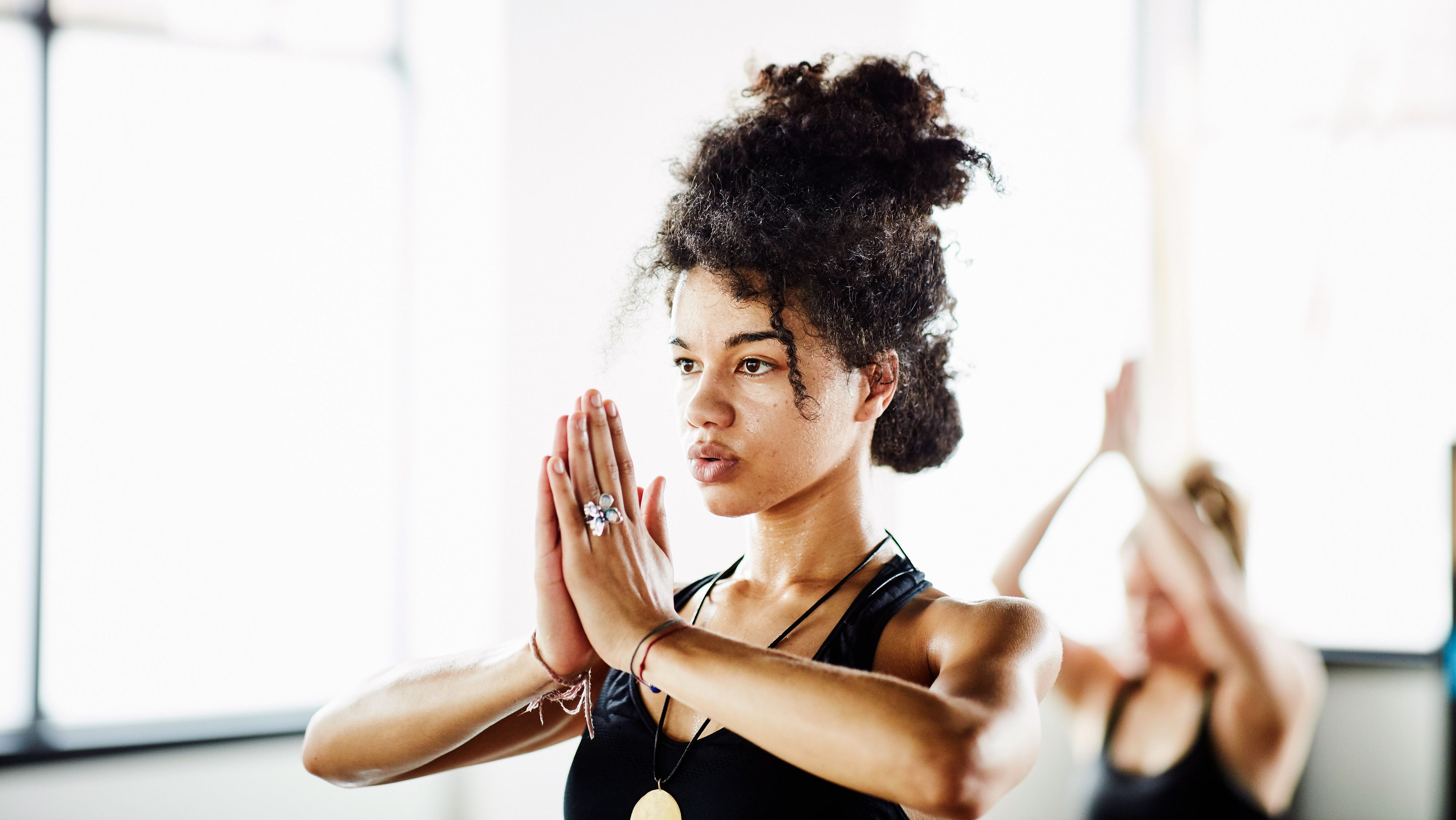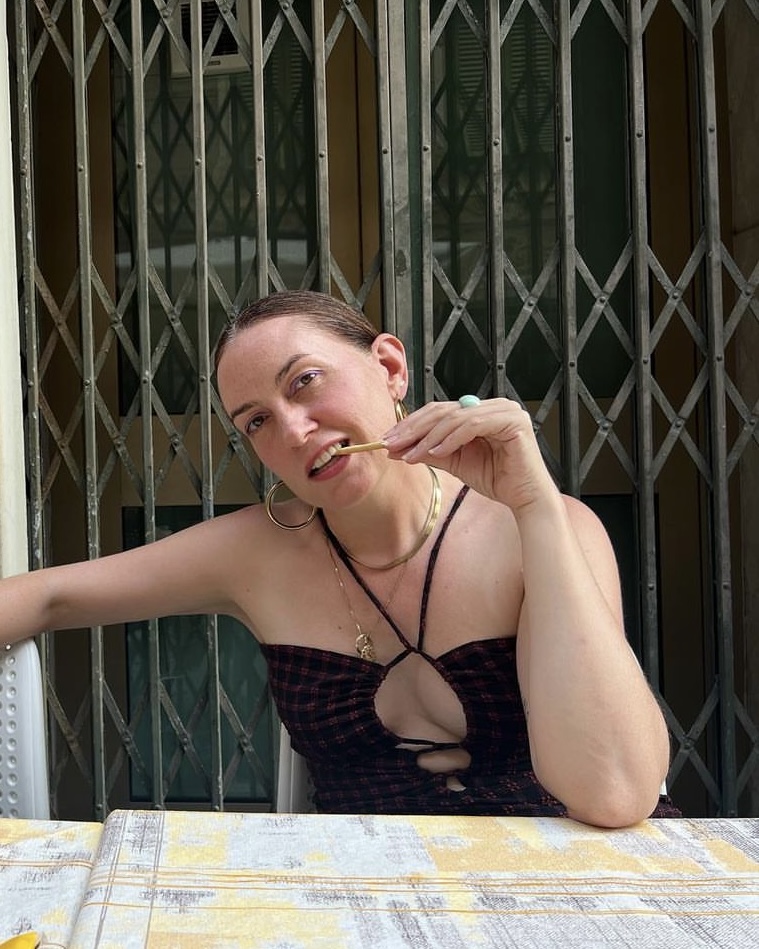How to Feel Better Now
That spin class? Swap it for a sound bath. Here are the mind- and body-easing measures to turn to when traditional anxiety easers don’t cut it.


This year has brought new levels of anxiety and pressure. And while all people have their own methods of dealing—some healthy, some less so—a growing number are beginning to look beyond traditional remedies like talk therapy and exercise in favor of alternative approaches. Think of these practices not as a means of escape but rather as paths for connecting, or reconnecting, with yourself.
For the Overworked: Restorative Fitness
And so the pendulum swings. Following a surge in popularity of HIIT and boot-camp-type workouts comes the rise of classes and studios that help the body slow down. “One of the greatest benefits of restorative practices is they down-regulate your stress response,” says yoga icon Eddie Stern, cofounder of Brooklyn Yoga Club and Ashtanga New York. “When this happens, the relaxation response can become more pronounced, leaving you with a feeling of calm, connectivity, safety, and a quiet mind.” With chronic stress becoming increasingly common, practices like restorative yoga, stretching-focused yin yoga, and intentional stretching feel that much more essential.
“It’s good to challenge your system with higher intensity activities for overall cardiovascular health, but recovery is equally important,” says NYU Langone sports-medicine specialist Lauren Borowski. For someone who is stressed, doing only high-intensity workouts can actually exacerbate the problem. “High-intensity workouts sometimes further deplete the system rather than release stress,” says Abby Paloma, who teaches restorative classes at New York’s Sky Ting yoga studios. “People need a nervous system that is fueled by rest and operates on cultivated energy, not a deficit.”
While restorative fitness methods counterbalance the constant muscle and joint contraction of active workouts, they also rebuild mobility after too much time spent in static positions, like sitting at your desk or commuting. “Your muscles and joints need to expand and lengthen to be fully optimized and to prevent or ease pain,” says Aimee Cho, cofounder of Outer Reach, a Manhattan stretching studio. “We call it mindful movement.” That’s key because while these methods may feel more restful, they are still active. “Sometimes when we slow down and quiet down, instead of experiencing deep ease, we actually become aware of our own restlessness,” says Paloma. “But just feeling that can be insightful and healing, even when it’s simultaneously uncomfortable.”
Why Stretching Classes Work for Me
Jenny Samuelson, 45, stay-at-home mom, New York City
I first discovered Outer Reach just from walking by it on the way to my kid’s school. When I saw that it was a stretching studio, I was confused; isn’t that something you can do on your own? But then I injured my back. I wasn’t able to sleep because the pain went all the way down my legs. I couldn’t even flex my left foot. I was so tight and miserable, and I wanted to try something different to treat it. When I went in for my first session, it was painful, but that night I was able to sleep for the first time in months. So I went back the next day, and then I just started incorporating sessions into my overall fitness practice. (I’ve been doing yoga for 10 years.)
This restorative routine has been an absolute game changer for me. The teachers I’ve been seeing are dancers, so they know their bodies incredibly well and how to access very specific muscles. What they do is very precise and minute, but those adjustments activate an entire line of muscles that I’d never activated. My flexibility has improved, and it’s actually really changed my yoga practice. It’s also just made me feel like I’m much more in tune with my body. I didn’t understand how pain affected me until it was no longer there. Now when something feels off or tight, I immediately check myself.
Get exclusive access to fashion and beauty trends, hot-off-the-press celebrity news, and more.
Rules of Engagement
Yin yoga and restorative yoga are often confused. The former involves focused stretching and holding postures, while the latter is about focused rest or, as Paloma calls it, “perfecting the doing of undoing.” In a restorative-yoga class, you’ll learn postures aimed at lowering your heart and respiration rates. You’ll be supported by bolsters, blankets, and blocks while lying on the floor in a low-lit setting. At Outer Reach, Cho calls the dynamic-stretching sessions, aimed at elongating, toning, and increasing flexibility and mobility, a form of “engaged bodywork.” For all restorative practices, your best bet is to wear comfortable clothes that allow for a range of motion without being restrictive but aren’t so loose that your instructor can’t keep an eye on your alignment.
For Focus Seekers: Microdosing

The exploration of psychedelic drugs (like psilocybin, LSD, and, more recently, MDMA) for medicinal versus recreational purposes is many decades old. In recent years, though, psychedelics have been experiencing a bit of a renaissance, thanks in part to firsthand accounts from the likes of writer Michael Pollan (his 2018 book How to Change Your Mind is devoted to the topic) and the late Steve Jobs. (He said taking LSD was one of the most significant things he’d done in life.)
Now, the drugs are further seeping into the mainstream via microdosing. Defined as an extremely low, sub-hallucinogenic dose of a substance, usually 1/10 to 1/20 of a typical recreational dose, “a microdose might slightly alter perception yet not impair one’s ability to function, and there would be none of the typical hallucinogenic effects,” says Emily Kulpa, research associate at the Toronto Centre for Psychedelic Science. Traditional doses, administered infrequently for long-lasting effects, remain at the heart of psychedelic therapy in the scientific community, says Matthew Johnson, the associate director of the Center for Psychedelic and Consciousness Research at Johns Hopkins, where they are being used to help with depression, anxiety, and smoking cessation. “Microdosing is born in the realm of symptom reduction or, for folks interested in more of the positive psychology side, symptom enhancement, so you have to keep taking it,” he says.
There haven’t been any significant scientific studies on microdosing yet (Johns Hopkins has secured funding to explore it), but the anecdotal reports of its benefits are fervent and far-reaching, touting improved mood, increased creativity, enhanced focus, and mental acuity. While Johnson thinks many of microdosing’s claims may result from a placebo effect, he admits it’s plausible that there are certifiable positive impacts, particularly as an antidepressant. “Microdosing is a way of tinkering with the serotonin system,” he says, “and we know that augmenting it in a chronic way can help with depression.”
Why Microdosing With LSD Works for Me
Tanya Akim, 29, writer, L.A.
I was really looking for a way to get my energy back. I had been hearing about a lot of different LSD therapies from friends in Northern California who work at MAPS (Multidisciplinary Association for Psychedelic Studies). I was deep into a counterculture yoga movement at the time, but I’d never dipped into drugs like that. I took a lot of Adderall in my teens because I have always had chronic fatigue, and I’ve struggled with clinical depression for years. But I don’t like feeling out of my body. The traditional microdose is subperceptual, so you don’t experience the hallucinations a type-A person like me would absolutely loathe. My goal was always to be high functioning, not over-steamed broccoli. The protocol I followed was based on James Fadiman’s guide; he’s the godfather of microdosing and author of The Psychedelic Explorer’s Guide. I did one day on, two days off; it was 10 doses over the course of a month.
The first time I did it, I wanted to be with a trusted friend. We went on a hike, and halfway through I felt this serotonin rush, like a large cold brew was kicking in, and I started sprinting. I’d literally never had that much energy in my entire life. Two days later, I started feeling very depressed, but my friend assured me this is common. They say it’s a rearranging of your neural furniture. The first week was the hardest, and then the following three weeks I felt happier than I’d ever felt. My ability to problem-solve was unbelievable, and I had so much focus and creativity and empathy toward people.
I’ve done a lot of psychotherapy, so this wasn’t my first foray into peeling back the layers. But I felt like I needed something extra because the antidepressants weren’t working. Meditation worked for a time, and then it didn’t. I tried all kinds of nootropics and brain oils, and nothing worked. Microdosing is the only thing I can say has ever actually made me feel incredible, and one month of it propelled me for an entire year. It was the most successful year of my life.
Rules of Engagement
Neither Kulpa nor Johnson supports microdosing, and they caution people against doing it on their own. Two of their concerns: Psychedelics are still classified as illegal substances, says Kulpa, and certain individuals may not be good candidates for their use. In addition, “the effects of psychedelics can last for hours, so if you accidentally end up taking too large a dose, you’ll have to sit with that experience for a while,” she says. Still, many acolytes are willing to take their chances. If you’re determined to try it for yourself, Akim suggests looking for a therapist or researcher who works with MAPS to ensure the best quality and most precise dosing, trying it at home or someplace you feel safe, and using the buddy system so you’re not putting anything unfamiliar into your body alone.
For the Meditation Averse: Sound Therapy

Sound is something that most of us experience on a daily basis, but we likely give very little thought to its impact. Whether we’re cognizant of it or not, sounds can dramatically influence our physical and emotional well-being, jolting our nervous system and upping our anxiety. Therapeutically working with sound isn’t as simple as listening to music. Instead, “sound is used to create an environment in which recipients can allow their mind to untether and shift brainwaves, moving from the more active beta state of alert waking consciousness into alpha and theta, which involve more introspection, creativity, and expansive thinking,” explains Nate Martinez, a sound-therapy practitioner in New York. For reluctant meditators, sound meditations and sound baths are an easy gateway; according to Martinez, many of his students previously thought quieting their minds was impossible.
Martinez relies on instruments and tools that produce overtone-rich sounds and have the ability to sustain tones (like crystal singing bowls, gongs, tuning forks, and shruti boxes), but never anything that people might have strong, formed relationships with, like a piano or guitar. “When I’m facilitating a meditation, [those instruments] might be a trigger for someone and get them thinking, thereby taking them out of the experience,” he explains. “Instruments that we have less formed relationships with allow us to be more open.” According to neurosurgeon Eben Alexander, most of the sounds associated with traditional music are processed in the acoustic cortex, but binaural beats (two tones at slightly different frequencies played in unison, produced naturally by instruments like singing bowls) literally go deeper. “They’re being processed at a circuit in the lower brain stem that evolved more than 300 million years ago, before mammals appeared on the scene, and that’s why they have so much power liberating conscious awareness from the shackles of the physical brain,” he says. Sound therapy’s results, report practitioners, are lower anxiety, better sleep, and improved concentration and focus.
Why Sound Bathing Works for Me
Jimena Garcia, 43, eyebrow artist, New York City
I went to my first sound bath 11 years ago. The whole thing was done using just a gong. I realized that there are frequencies that we experience that trigger different emotions and memories, or things I’d never felt before, that I had filed away in my subconscious. Then I went to one of Nate [Martinez’s] sound baths, which are a composition of many different instruments, with different frequencies and vibrations. That meditation took me on more of a journey. It wasn’t just a single feeling, but it took me through the whole package of happiness, sadness, trauma. The experience goes straight to the core. We have so many distractions now and so many things that influence us, so being able to get to that place is very difficult. And for me it’s really difficult to just meditate without the help of sound; sound is a support system that holds you and takes you there. I now do sound baths monthly because they help me find the answers I need.
Rules of Engagement
At a typical sound bath, you’ll be stretched out on a yoga mat in a dark or low-lit room. Wear clothes you’re comfortable lying down in; bring a blanket if you tend to get cold and an eye mask if you need further encouragement to keep your eyes closed and zone out. Most important, be okay with leaving your phone for a while, and give yourself time afterward to digest the experience; if you immediately jump on a conference call or head out for brunch, you risk missing out on the reward: a sense of calm. Programs like the Sacred Acoustics app and other meditation recordings allow anyone to access and regularly experience the benefits of sound at home.
Serenity Now: Three ways to immediately address your anxiety
Commune with Nature
Did your parents constantly insist you go play outside as a kid? They had a point; research has shown that spending time in nature boosts the immune system and improves overall well-being. To add a mindfulness element to your nature exploration, consider forest bathing. The Japanese practice involves taking a slow stroll through nature, actively experiencing the scents and sounds around you, according to Nina Smiley, director of mindfulness programming at Mohonk Mountain House in New Paltz, New York. No forest in close proximity? “Bathe” in a park or even your backyard, and if those aren’t available, bringing nature into your home has a similar effect. Says Smiley, “Choose an air-purifying plant, like ivy or aloe, and during stressful moments take a short break to simply observe it, breathe gently, and clear the mind.”
Just Breathe
That advice may seem simplistic, but wielding our breath with intention can be a powerful tool. Controlled breathing practices, like pranayama, are designed to regulate the body and mind, explains Christiana Schelfhout, a healing-arts practitioner at Shou Sugi Ban House, a wellness resort in Montauk, New York. “With practice, you gain the ability to shift the body into a parasympathetic [rest and digest] state, increase energy, heighten focus, and boost immune function.” One exercise Schelfhout recommends to balance an overstimulated mind is sama vritti: Inhale through the nose for four seconds, pause for four seconds, exhale for four seconds, hold the exhale for four seconds. Repeat as needed, increasing length as you become more comfortable.
Get Hands On
Not only does it feel great, massaging the hands and the feet is also a quick way to calm down. “When you’re spinning out, rubbing the soles of the feet and the palms of the hand —which are like analogues with each other—can ground you,” says Brooklyn–based acupuncturist and owner of Lanshin studio Sandra Chiu. To ease stress, she also focuses on the back of the neck, specifically the occipital bone at the upper point of the neck where it meets your head, massaging from ear to ear. “A lot of people have a tremendous amount of locked-down tension there,” says Chiu. “Your psychology follows your physiology, so if you can reduce muscle tension there, you will reduce your anxiety level, because they go together.”
This article originally appeared in the Summer 2020 issue of Marie Claire.
RELATED STORIES



Fiorella Valdesolo is a contributing editor at the Wall Street Journal Magazine, and has written for New York, Vogue, Town & Country, Allure, Time, National Geographic, CR Fashion Book and Oprah. She was the cofounder and Editor-in-Chief of the late James Beard Award–winning food magazine Gather Journal. She lives in Brooklyn with her partner Nate, their six-year-old daughter Aluna, and their dog Rosie.